Best
Percussion Instrument for Beginners
-
Overall: Can be held in the hand or mounted on a stand, and can be played in numerous ways
-
Best Feature: Suitable for many musical applications and is an ideal addition
-
TedScore™: 9/10
Best
Percussion Instrument for Intermediates
-
Overall: A bundle containing 23", 26", 29" and 32" Timpani
-
Best Feature: Provide a cost-effective alternative to copper bowled timpani without compromising on quality
-
TedScore™: 9/10
Best
Percussion Instrument for Professionals
-
Overall: Everything you need to get playing right away with headphones, drum sticks & stool
-
Best Feature: Incredibly responsive mesh drum pads, without the huge price tag
-
TedScore™: 10/10
Consider how vital percussion instruments are in music. From the booming timpani to the tinkling triangle, they form the largest group in an orchestra. They deliver excitement, rhythm, and a burst of colour.
Percussion instruments can be tuned or untuned and can produce a range of sounds, from roaring thunder to clear tinkling bells.
They’re an essential part of any musical ensemble and have been used throughout history to provide the backbone or heartbeat of a piece of music.
This article will explore percussion instruments’ fascinating world, history, and musical benefits. So, grab your drumsticks and let’s begin!
What are percussion instruments?

A percussion instrument is a musical instrument that produces sound by being struck or scraped.
It’s a broad category of instruments, including drums, bells, cymbals, xylophones, maracas, and more. The orchestra’s largest percussion family is believed to include the oldest musical instruments, excluding the human voice.
Percussion instruments can be either tuned or untuned, with tuned instruments producing different notes and untuned instruments producing no definite pitch.
They’re vital in keeping the rhythm, making special sounds, and adding excitement and colour to music.
Unlike many other players in the orchestra, percussionists typically play many different instruments in one piece of music. In jazz and other popular music ensembles, the pianist, bassist, drummer, and sometimes the guitarist is called the rhythm section.
Understanding and incorporating percussion in music is crucial for any musician, whether in an orchestra, a band, or any other genre of music.
Importance of Percussion in Music

Percussion is a fundamental element in any music. It’s a vital inclusion in music that gives it unique character, emotion, and soul.
Without percussion instruments, music would lack its rhythm and soul. Percussion is not just about keeping time but can also add melody and harmony to the music.
This backbone and heartbeat of music help blend all the other instruments, creating a cohesive sound.
Learning to play percussion instruments can be challenging, but it offers numerous benefits. It improves both kids’ and adults’ coordination, motor skills, and even ambidexterity. Playing these instruments is a great workout that engages hands, fingers, arms, and feet, providing an accelerated immune response that can help fight diseases.
Playing percussion instruments can be done individually or in groups, bringing people together through a common ground of unique music-making. It’s an avenue for expressing one’s true self by creating music with their own two hands.
List of Instruments in the Percussion Family
The percussion family of instruments is the largest in the orchestra, and it includes a wide array of instruments that are used to keep the rhythm, create special sounds, and add excitement and colour to music.
An orchestra’s most commonly used percussion instruments include the timpani, xylophone, cymbals, triangle, snare drum, bass drum, tambourine, maracas, gongs, chimes, celesta, and piano.
Some percussion instruments are tuned and can sound different notes, like the xylophone, timpani, or piano. In contrast, others are untuned with no definite pitch, like the bass drum, cymbals, or castanets.
Other instruments in the percussion family less commonly used in orchestral music include woodblocks, cowbells, kettle drums, agogo bells, and claves.
It’s important to note that the percussion family also includes a variety of non-western instruments, such as African drums and South American shakers, all of which have unique sounds and traditions.
Here’s a list of the most commonly used percussion instruments.
1. Timpani
Large, kettle-shaped drums tuned by adjusting tension on the skinheads. Produce rich, resonant tones, adding depth to orchestral compositions.

COMES WITH: Premium bundle containing 23", 26", 29" and 32" Orchestral Timpani
FEATURES: Lightweight and rugged fibreglass bowls
WHD COMPLETE TIMPANI DRUM SET
When you check the price above, you’ll see there are loads of great places to buy this item. Our personal favorite is Gear4music.
It is the largest music retailer in the UK and fast becoming the most respected online music shop in the US too. Their customer service is excellent, they have competitive prices, really fast shipping, and usually have the longest guarantee.
Most professional musicians use Gear4music, so there is no reason why you shouldn’t too!
- Provide a cost-effective alternative to copper bowled timpani without compromising on quality
- Also includes protective covers and pairs of Timpani mallets
- Mallets not included
The professional musician who wrote this article combined many things,
from the product build, manufacturer’s reputation through to feedback
from other users, to create our famous TedScore™.
2. Xylophone
Percussion instrument with wooden bars of varying lengths. Struck with mallets to create bright, melodic notes in a charming, crystalline timbre.

COMES WITH: Exclusive Yamaha tuning method ensures true pitch and full sound
FEATURES: Graduated bars produce a full tone and projection
Yamaha YX35G Xylophone, 3.5 Octaves
When you check the price above, you’ll see there are loads of great places to buy this item. Our personal favorite is Gear4music.
It is the largest music retailer in the UK and fast becoming the most respected online music shop in the US too. Their customer service is excellent, they have competitive prices, really fast shipping, and usually have the longest guarantee.
Most professional musicians use Gear4music, so there is no reason why you shouldn’t too!
- Height adjustable frame provides extra comfort
- The frame is compact which is great for a travelling musician
- Suitable for most styles of music from orchestral works through to wind bands and brass bands
- Smaller bars create a lesser quality tone and dynamic range
The professional musician who wrote this article combined many things,
from the product build, manufacturer’s reputation through to feedback
from other users, to create our famous TedScore™.
3. Cymbals
Circular, metal concave plates clashed together to produce shimmering, crashing sounds that punctuate music with dramatic flair.

COMES WITH: a combination of hi-hats, crashes, and ride cymbals
FEATURES: Each cymbal is hand-hammered by skilled artisans
Sabian HHX Complex Performance Set
When you check the price above, you’ll see there are loads of great places to buy this item. Our personal favorite is Gear4music.
It is the largest music retailer in the UK and fast becoming the most respected online music shop in the US too. Their customer service is excellent, they have competitive prices, really fast shipping, and usually have the longest guarantee.
Most professional musicians use Gear4music, so there is no reason why you shouldn’t too!
- Covers a wide range of musical genres and playing styles
- Complex tonal character, offering a blend of bright and dark tonalities
- Higher price point compared to other cymbal sets
The professional musician who wrote this article combined many things,
from the product build, manufacturer’s reputation through to feedback
from other users, to create our famous TedScore™.
4. Triangle
Simple, triangular metal bar that produces a clear, tinkling sound when struck with a metal beater. Adds delicate accents and sparkle.
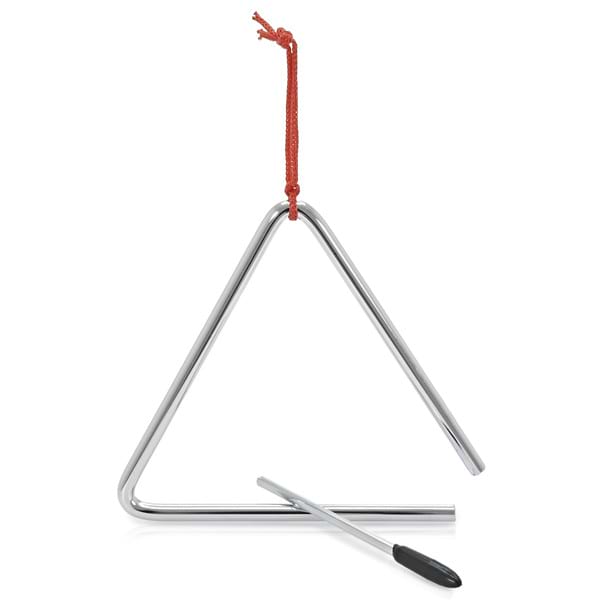
COMES WITH: striker or beater, often made from metal or another hard material
FEATURES: produces a higher-pitched and bright sound
Triangle 8'' by Gear4music
When you check the price above, you’ll see there are loads of great places to buy this item. Our personal favorite is Gear4music.
It is the largest music retailer in the UK and fast becoming the most respected online music shop in the US too. Their customer service is excellent, they have competitive prices, really fast shipping, and usually have the longest guarantee.
Most professional musicians use Gear4music, so there is no reason why you shouldn’t too!
- Small size and lightweight nature make it easy to transport and incorporate into various setups
- Can be associated with orchestral and ensemble music
- Has a limited pitch range
- Sound is singular and doesn't offer the tonal complexity of other percussion instruments
The professional musician who wrote this article combined many things,
from the product build, manufacturer’s reputation through to feedback
from other users, to create our famous TedScore™.
5. Drum Kit
Collection of drums and cymbals played simultaneously by a drummer. Creates rhythmic foundation in various genres from rock to jazz.
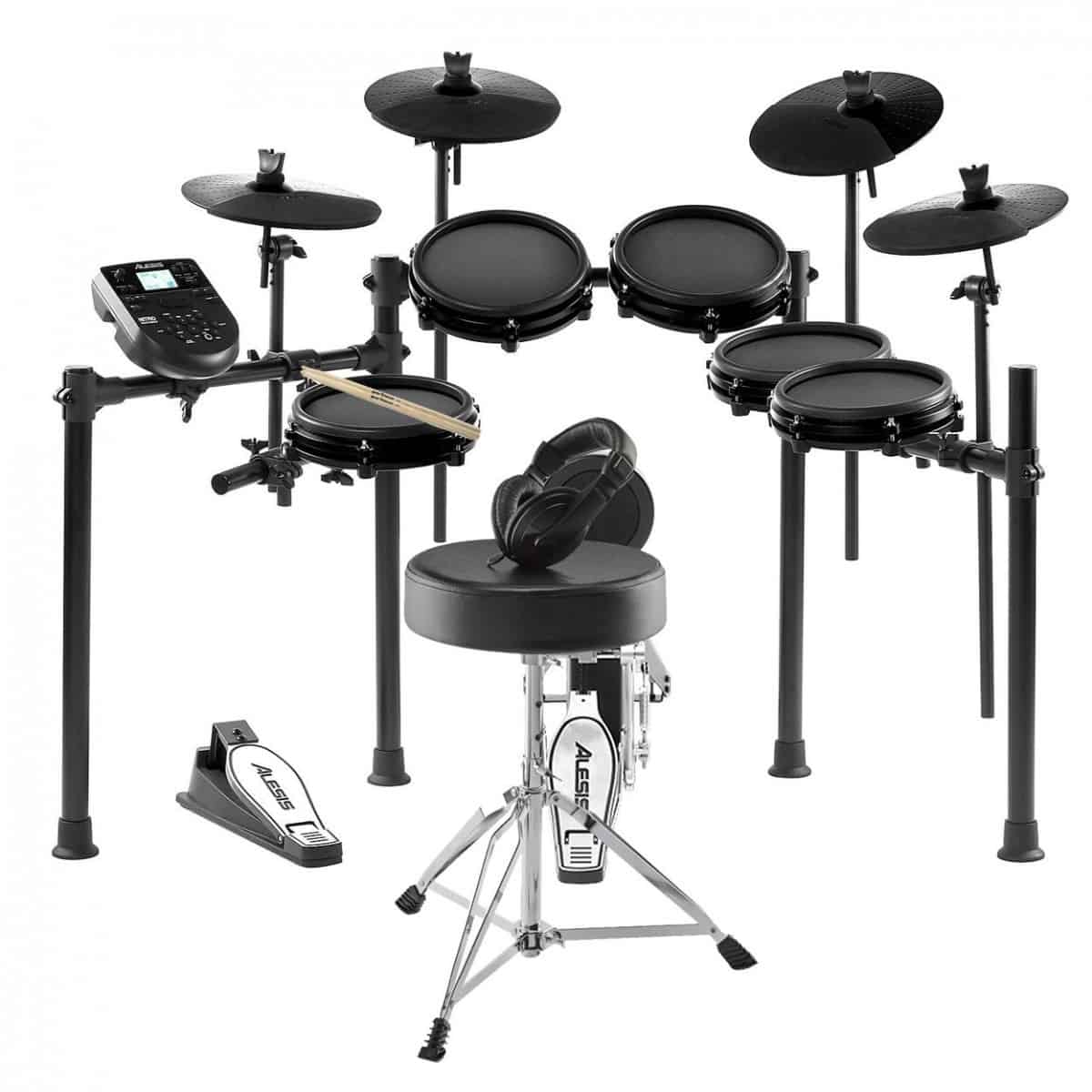
COMES WITH: Built-in coaching
FEATURES: 350+ built-in sounds
Alesis Nitro
Mesh Complete
Expansion Bundle
When you check the price above, you’ll see there are loads of great places to buy this item. Our personal favorite is Gear4music.
It is the largest music retailer in the UK and fast becoming the most respected online music shop in the US too. Their customer service is excellent, they have competitive prices, really fast shipping, and usually have the longest guarantee.
Most professional musicians use Gear4music, so there is no reason why you shouldn’t too!
- Headphones, drum sticks & stool included
- The cozy sponge and leather pads also cut down on outside noise
- Everything you need to get playing right away
- The trade off for having everything you need is that this is a large electric kit, so you will need a good size space to set-up before playing
The professional musician who wrote this article combined many things,
from the product build, manufacturer’s reputation through to feedback
from other users, to create our famous TedScore™.
6. Tambourine
Small, handheld frame drum with jingling metal disks around the edge. Shaken or struck, it adds rhythmic texture and light jingling tones.

COMES WITH: equipped with metal jingles that create a distinct jingling sound
FEATURES: Made from durable materials
Tambourine by Gear4music, 9"
When you check the price above, you’ll see there are loads of great places to buy this item. Our personal favorite is Gear4music.
It is the largest music retailer in the UK and fast becoming the most respected online music shop in the US too. Their customer service is excellent, they have competitive prices, really fast shipping, and usually have the longest guarantee.
Most professional musicians use Gear4music, so there is no reason why you shouldn’t too!
- Creates a bright and lively rhythmic accent
- Fits well in various musical genres, from folk and rock
- Small size and lightweight design make it easy to carry
- Sound palette is relatively limited
The professional musician who wrote this article combined many things,
from the product build, manufacturer’s reputation through to feedback
from other users, to create our famous TedScore™.
7. Maracas
Pair of hollow, handheld percussion instruments filled with seeds or beads. Shaken to produce lively, shaking rhythms.

COMES WITH: a length of 26cm, these maracas are comfortable to hold and play
FEATURES: have a traditional and authentic appearance, offering a tactile playing experience
Stagg 26cm Wood Maracas, Mexican
When you check the price above, you’ll see there are loads of great places to buy this item. Our personal favorite is Gear4music.
It is the largest music retailer in the UK and fast becoming the most respected online music shop in the US too. Their customer service is excellent, they have competitive prices, really fast shipping, and usually have the longest guarantee.
Most professional musicians use Gear4music, so there is no reason why you shouldn’t too!
- Unique percussive texture to a wide range of musical genres
- Require minimal technique to produce sound
- Achieving different volume levels can be challenging with maracas
The professional musician who wrote this article combined many things,
from the product build, manufacturer’s reputation through to feedback
from other users, to create our famous TedScore™.
8. Gongs
Large, flat metal discs with varying sizes and thicknesses. Struck with a mallet to produce deep, reverberating tones of varying pitches.
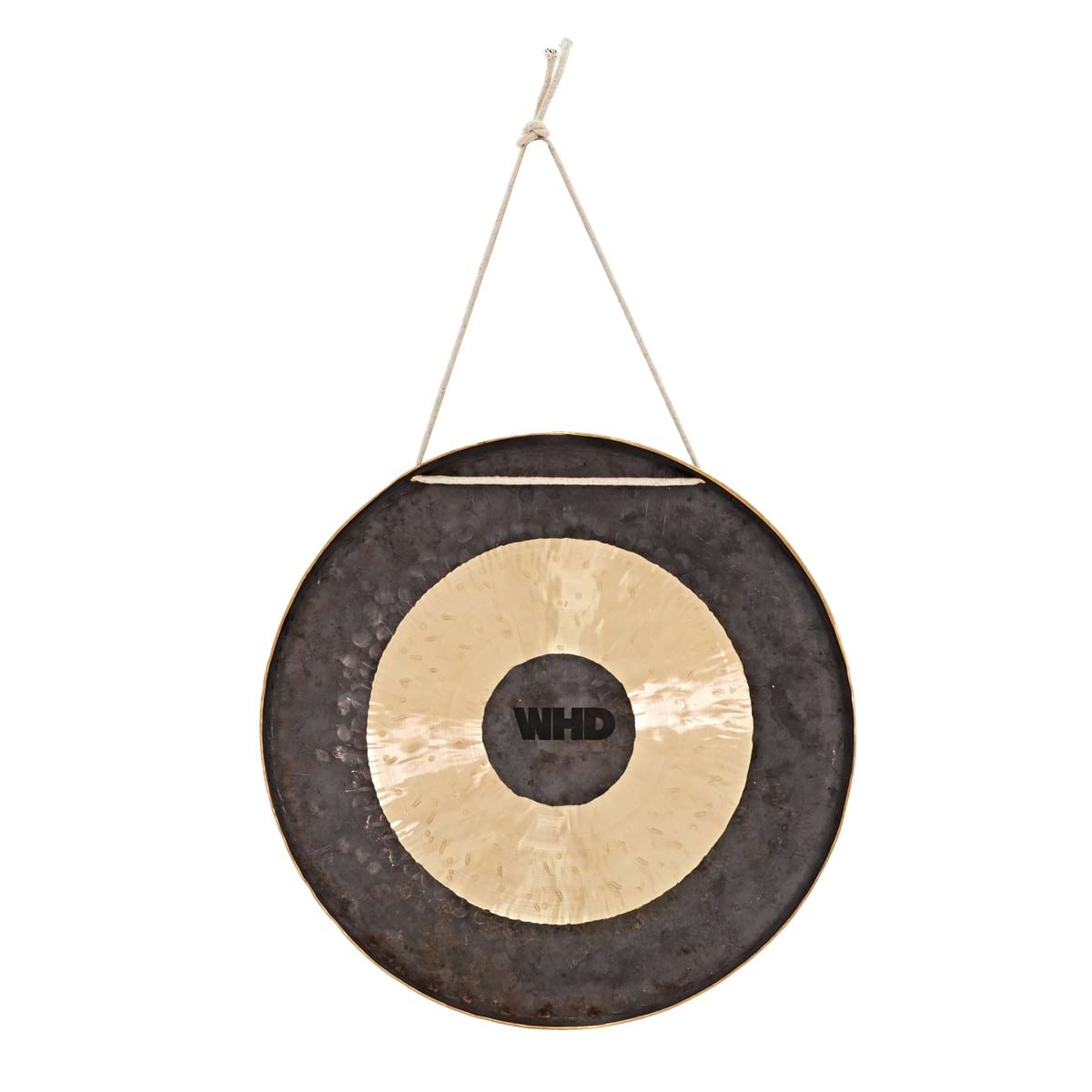
COMES WITH: A mallet or beater for playing
FEATURES: produces a deep, low-frequency sound with complex overtones
16" Chau Gong by Gear4music
When you check the price above, you’ll see there are loads of great places to buy this item. Our personal favorite is Gear4music.
It is the largest music retailer in the UK and fast becoming the most respected online music shop in the US too. Their customer service is excellent, they have competitive prices, really fast shipping, and usually have the longest guarantee.
Most professional musicians use Gear4music, so there is no reason why you shouldn’t too!
- Deep and rich sound has a profound impact
- Can be used creatively in various musical contexts
- Add a captivating visual element to performances
- Might not offer the same level of pitch variation as some other percussion instruments
The professional musician who wrote this article combined many things,
from the product build, manufacturer’s reputation through to feedback
from other users, to create our famous TedScore™.
9. Chimes
Set of suspended metal tubes that produce ethereal, bell-like tones when struck. Used to create delicate, shimmering effects.

COMES WITH: Carrying case, Mallets, and Instructional Materials
FEATURES: constructed from high-quality materials like metal or aluminum
Stagg Pipe Chimes, 25 Bars
When you check the price above, you’ll see there are loads of great places to buy this item. Our personal favorite is Gear4music.
It is the largest music retailer in the UK and fast becoming the most respected online music shop in the US too. Their customer service is excellent, they have competitive prices, really fast shipping, and usually have the longest guarantee.
Most professional musicians use Gear4music, so there is no reason why you shouldn’t too!
- 25 bars of varying lengths offer a broad tonal range
- Relatively easy to play
- Visual and auditory appeal of the chimes can enhance the overall performance
- Overall size may make them less suitable for travelling musicians
The professional musician who wrote this article combined many things,
from the product build, manufacturer’s reputation through to feedback
from other users, to create our famous TedScore™.
10. Piano
Grand or upright keyboard instrument. And yes – the piano is technically a percussion instrument!
Strings struck by hammers when keys are pressed, offering a wide dynamic range and versatility for melodies and harmonies.
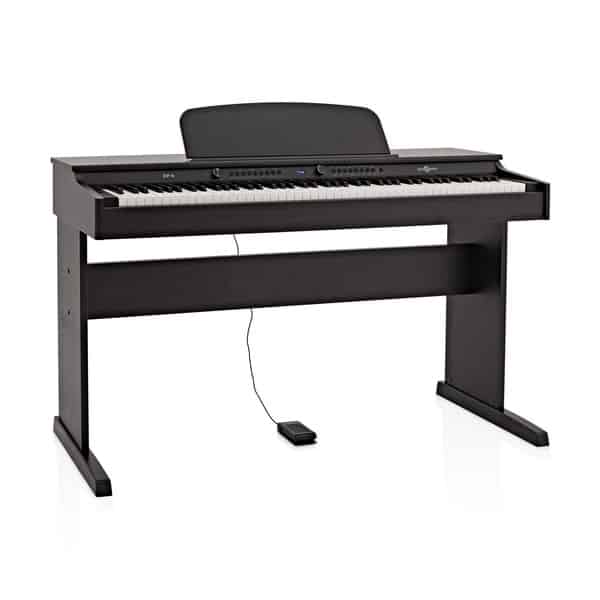
PERFECT FOR: beginner players
FEATURES: Allows two players to play simultaneously with its duet mode
OTHER INFO: Features 88 weighted keys and 64 polyphony features
DP-6 Digital Piano by Gear4music
When you check the price above, you’ll see there are loads of great places to buy this item. Our personal favorite is Gear4music.
It is the largest music retailer in the UK and fast becoming the most respected online music shop in the US too. Their customer service is excellent, they have competitive prices, really fast shipping, and usually have the longest guarantee.
Most professional musicians use Gear4music, so there is no reason why you shouldn’t too!
- Boasts a user-friendly interface and intuitive design that make it easy to navigate
- Offers many musical possibilities for every player
- Great option for beginners on a budget
- Does not include a bench
- The included headphones may not have the highest quality
The professional musician who wrote this article combined many things,
from the product build, manufacturer’s reputation through to feedback
from other users, to create our famous TedScore™.
Tuned and Untuned Instruments

There are two main categories for percussion instruments: tuned and untuned.
Tuned instruments produce a sound of definite pitch, meaning they play a specific note. Examples of tuned instruments include the xylophone, timpani, and piano.
On the other hand, untuned instruments produce a sound of indefinite pitch. Examples of untuned instruments include the bass drum, cymbals, and castanets.
It’s important to note that some instruments, such as the triangle, can fall into both categories.
Understanding the difference between an unturned and tuned instrument is crucial in creating a cohesive and balanced piece of music. Tuned instruments can contribute to the melody and harmony of a piece, while untuned instruments often provide rhythm and texture.
Many percussionists are skilled in both types of instruments, which can add depth and complexity to their performances.
How are percussion instruments classified?
Percussion instruments are classified based on different criteria, with the most widely used classification system focusing on how these instruments produce sound.
Four criteria are used for classifying percussion instruments: the means of sound production, musical usage, the means of playing the instrument, and the origins or significance of the instrument.
However, due to percussion instruments’ varied nature and usage, their classification can be difficult, and different systems are often used in different contexts.
Historically, ancient Chinese and Indian classification systems were based on the materials of which the instruments were constructed. In contrast, Western classification systems date back to the 14th century with systems that divided all musical instruments into three classes: percussion, wind, and string instrument.
Regardless of how percussion instruments are classified, it’s important to recognize their role in music as instruments that keep rhythm, create special sounds, and add excitement and colour to musical performances.
Examples of Each Classification
There are several overlapping schemes for classifying percussion instruments, which are based on four types of criteria. Depending on how the sound is produced, the classification might vary.
The most widely used classification system considers the traditional division into tuned and untuned instruments and the similar, more modern division into pitched and unpitched instruments. The means of playing the instrument and the skills required also determine the classification.
Furthermore, instruments are grouped according to their usage and significance or based on their origin. Examples of percussion instruments in each classification include timpani, xylophone, and glockenspiel for tuned instruments and bass drum, cymbals, and triangle for untuned instruments.
Snare drum, tambourine, and maracas fall under the category of idiophones because the instrument is struck either with a non-sonorous object or against a non-sonorous object.
Meanwhile, tam-tam, gongs, and thunder sheets indirectly strike idiophones because percussion results indirectly through some other movement by the player.
Lastly, the membrane instruments category includes bass drums, snare drums, and timpani. Understanding and incorporating percussion in music can add support, rhythm, and excitement, making it an essential, vibrant part of the orchestra.
Importance of Understanding and Incorporating Percussion in Music
Understanding incorporating percussion in music is incredibly important for any musician or band. Percussion instruments provide the rhythm and timing that make music cohesive and create a solid foundation for other instruments to build upon.
Percussion instruments can range from a simple tambourine to a complex drum kit, but they all contribute to the overall sound and experience of the music. Playing a percussion instrument can be challenging, but it’s a valuable skill that greatly enhances a musician’s abilities.
Aside from providing rhythm and timing, percussion instruments can also create exciting and dynamic sounds that add depth and excitement to a performance. From the snare drum’s sharp snap to the mallet instruments’ rich resonance, percussion instruments offer a wide range of possibilities for creative expression.
By understanding and incorporating percussion in their music, musicians can create a more complete and compelling auditory experience for their listeners.
For a complete list of percussion instruments, see our article PERCUSSION FAMILY INSTRUMENTS.
The Ultimate Percussion Instruments List
Summary
Percussion instruments are some of the oldest manmade musical instruments, and they come in a vast array of shapes and sizes. These instruments are played by striking, shaking, or scraping them to produce sound.
They can be classified into two groups, idiophones and membranophones. Idiophones are instruments that produce sound by vibrating their substance, while membranophones produce sound by the vibration of a stretched membrane.
Drums are some of the most popular percussion instruments, and they come in different shapes and sizes. From the bass drum to the snare drum, each drum produces a unique sound that adds to the rhythm of the music.
In conclusion, percussion instruments are an essential part of any musical ensemble. They add rhythm, texture, and depth to the music, making it more engaging and captivating.
Whether a professional musician or a beginner, learning to play percussion instruments can be a fun and rewarding experience. So why not try it and add some rhythm to your life?
Wait, there’s more!!!
If you’re a beginner drummer, you don’t have to break the bank to get started – electronic drum kits are a great option for practising at home without disturbing your neighbours (or your wallet).
Check out this next article and prepare to unleash your inner rock star!
FAQ's
Many percussion instruments include drums, cymbals, tambourines, maracas, xylophones, gongs, triangles, cowbells, bongos, and congas. Each instrument has its unique distinctive sound and purpose in creating rhythm and music.
It isn’t easy to give a definitive answer as new ones are always being created. However, according to The Percussive Arts Society International Convention & Exposition (PASIC), around 1,100 different types of percussion instruments are listed in their official repertoire database.
An orchestra’s most common percussion instruments include the timpani, snare drum, bass drum, cymbals, triangle, tambourine, xylophone, maracas, gongs, chimes, celesta, and piano. However, percussionists often play various instruments, depending on their music genre.
Percussion instruments can generally be divided into three categories: pitched percussion, unpitched percussion, and keyboard percussion.
Pitched percussion includes instruments like the xylophone and marimba, while unpitched percussion includes instruments like the snare drum and bass drum. Keyboard percussion includes instruments like the vibraphone and glockenspiel.



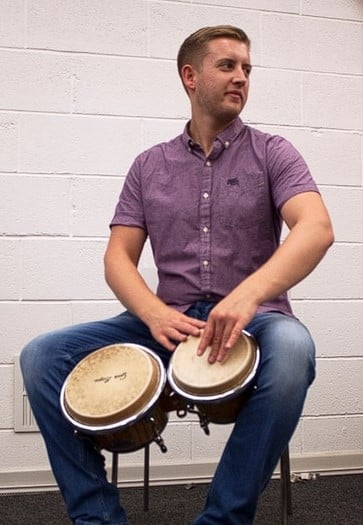






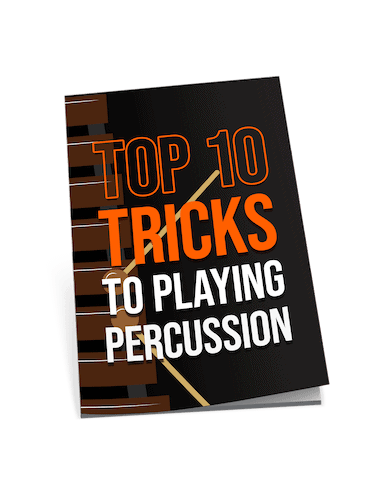
The triangle’s gotta be the most epic of them all, am I right? Imagine being in a band just to play the triangle, rockstar life!
While I can understand the classification of instruments is crucial for educational purposes, I believe the boundaries between percussion and other families are sometimes too artificially rigid. For instance, the piano functions mechanically more like a string instrument but is played percussively. Shouldn’t we consider a more fluid categorization that reflects the multifaceted nature of music instrumentation? This could foster a deeper understanding and appreciation for music’s complexity.
Interesting point! Never looked at it that way before.
i always thought that piano wasn’t really a percussion instrument, but i see you listed it. can sombody explain why is it categorized like that?
Loved the part about the drum kit! It’s amazing how versatile percussion instruments can be. Makes me appreciate music even more. Great write-up, Sam .
I dabble in guitar but percussion is a whole new world for me. So fascinating!
Yeah, the drum kit is super cool! Do you play any instruments yourself?